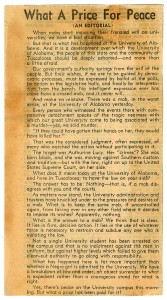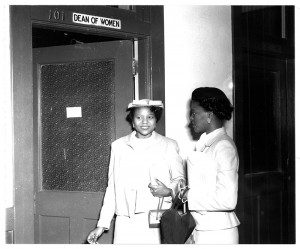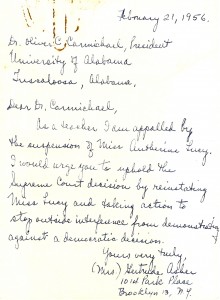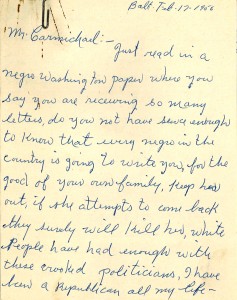Sixty years ago, the first major step was made toward desegregating the University of Alabama. Autherine Lucy, a black woman from Shiloh, Alabama, was enrolled – and a few days later suspended, eventually expelled, though she had done nothing wrong.
We tend to focus on 1963, on the bizarre segregationist pageantry of the Stand in the Schoolhouse Door, perhaps because it was ultimately unsuccessful. This week, we want to focus on something harder to take in but just as important to remember: when segregation unfortunately won.
In addition to this post, see the entry on our sister blog for the digital archives unit: February 1956: When the Eyes of the World Were on Us.
Hoole Library holds several collections related to the Autherine Lucy enrollment controversy. They range from published materials to photos and manuscripts to University Archives.
The Editor’s View
Buford Boone was editor of the Tuscaloosa News from 1947 to 1968, so he was witness to both attempts at integrating the University. Throughout the Lucy incident, Boone wrote editorials hailed across the country for their opposition to mob rule and racism. His most widely republished was this short editorial. (Click the image to see a larger version.)
In 1957, he won a Pulitzer Prize for Editorial Writing for his coverage of the events. He was also involved in bringing to light the activities of the Ku Klux Klan.
Hoole has a large collection of his materials (Buford Boone papers, MSS.0187), including copies of these editorials and the responses of readers around the community and the U.S. According to the finding aid,
This collection will be of great interest to anyone investigating the history of civil rights in Alabama in particular, or the South in general. Mr. Boone published the only newspaper in town from 1947-1974, and thus controlled information flow to a very great extent. His papers are interesting as a study of a man who had convictions and stuck by these convictions even in the face of certain unpleasant consequences.
In addition to the Boone materials, Hoole also has copies of the Tuscaloosa News from that period, as well as other Alabama periodicals, which can be found in the UA Libraries catalog.
The Camera’s Eye
Images of Autherine Lucy can be found in the University’s official collection of images, but two photographers who were there during Lucy’s entrance and the subsequent riots also donated to us their photos. It is conjectured that these men may have been employed as photographers with the University or the local media.
The 6 photographs in the Don Sanford photograph collection (2010.021) show Lucy walking and talking with others.
Though they are likely staged, they at least focus on Lucy herself.
The 23 photographs in the James William Oakley Jr. photograph collection (2010.020) chronicle the protests, both on campus and in downtown Tuscaloosa.
They feature white people engaging in demonstration and vandalism, with no African American faces to be seen.
The World’s Reaction
During and after the events of February 1956, UA President Oliver Carmichael was in an unenviable position. His papers (President Oliver C. Carmichael, RG.013) make up part of the University Archives, and they are open to the public.
In them, among other things, you’ll find Accession #19820768, which contains three entire boxes of correspondence received from people at home and abroad. They reflect a range of opinions on everything from segregation to the students’ violent behavior to Carmichael’s handling of the situation. Here are some examples. (Click any image below to see a larger version.)









2 Responses to Chronicling UA’s First Steps Toward Desegregation